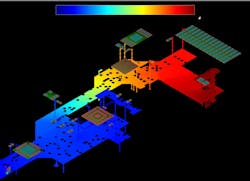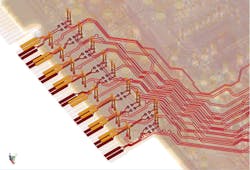Software strategy leverages design and test links
Keysight Technologies is investing in a strategy that requires a strong focus on specific industries. The strategy involves pulling together different Keysight products to create solutions to customers’ problems. “To do that, you need software,” said Todd Cutler, Software Program Operation and EEsof EDA vice president, in a recent phone interview. Software, he said, will solve the challenges of communication and getting different pieces of test equipment to work together. “So what that naturally means is we need a lot more software capability as part of our product offering. I think we will benefit ourselves and our customers by building on our strong software foundation, and that’s where we are making the investments.”
Keysight, of course, is a spinoff of Hewlett-Packard by way of Agilent Technologies. HP got into the electronic design automation business in the late 1980s, even before it acquired the EDA company EEsof. “HP’s move into EDA grew out of our own internal need for simulation and modeling tools that would help us design high-frequency equipment better,” Cutler said. He helped develop the HP 8510 vector network analyzer, and it became clear that the software tools used to develop HP instruments could meet other companies’ needs as well. Indeed, Cutler helped found the computer-aided engineering group within HP, and the group successfully turned the company’s internal software tools into external products.
“And then in 1993, we bought EEsof, which was in a very similar field offering a similar type of product,” Cutler said. “We were able to marry our products, which ultimately resulted in our flagship product, the Advanced Design System, or ADS.” Cutler left HP in 1998 to become CEO of Eagleware, the EDA company that pioneered the affordable Genesys RF and microwave design software. In 2005, he joined Agilent Technologies following Agilent’s acquisition of Eagleware, and he held various positions at Agilent before becoming general manager of Agilent EEsof in 2011.
Originally, Cutler said, EEsof as part of HP operated as an independent standalone business charged with selling software to designers to help them make their designs more effective. However, test-equipment divisions within HP and subsequently Agilent had been looking at how to improve test. “And over the last couple of years,” he said, “we have come to believe that now the time is right to connect the design world with the measurement world—particularly in verification.”
Contributing to the time being right, he said, are advances in computer infrastructure and computer science. He added, “What you’re going to see over time is much tighter coupling between our design software and our test software. The result will be a much more fluid environment that supports the workflow from original concept all the way through to manufacturing test.”
Industries and applications
Part of Keysight’s strategy going forward is a focus on industries and applications. “Our customers have been asking for that for some time,” Cutler said. “They say, ‘OK, great, you make individual instruments and individual software products and maybe tie some of these things together. But I have specific problems that require multiple instruments to work together.’”
Cutler explained that historically the company did focus on the products themselves and not as much on specific customers or customer types. “We’ve redirected our organization internally and shifted the focus from product-first to customer-first.”
He elaborated on what this customer-first focus means. The automotive and power electronics industry, for example, represents customers that have a particular set of needs, and Keysight now has established a core business unit that focuses on automotive electronics. Other areas of focus include the wireless-semiconductor and network-access industries, such as base stations, switching fabric, and cloud devices. “It’s been a real shift away from just products toward customers,” Cutler said. “We are gaining a deeper understanding of what those customers are looking for and what their business problems are. We are able to craft better solutions that bring all of the power of Keysight to bear to help them solve those problems.”
When asked if Keysight will be more software-focused going forward, he said, “First, I think we will be more software focused, but that’s not to say we don’t already have a very large software presence—not only in the electronic design automation or EEsof business, but also for test applications.” In fact, he said, in 2014, Frost & Sullivan named Keysight the number 1 supplier of instrumentation software, and that was before Keysight bought Anite in 2015, further strengthening its software position.
EDA and test convergence
When asked if he sees a convergence of EDA and test software over the coming years, he said, “Absolutely. And it’s not just us. I think you’ll find other people in the industry starting to talk about this as well, and I think it comes down to the desire to get the highest quality products to market as quickly as possible and at the lowest cost.”
Today, he said, it remains the case that the design world and the test world are largely separate. If you look at the organizations within companies, you find a group of designers performing simulations in the virtual world and then a separate group that actually tests or validates the design when a prototype becomes available. Because these groups are organizationally separate, a lot of work ends up being redone.
Keysight, Cutler said, sees an opportunity to leverage the work done at the design and validation stages so validation engineers don’t start from scratch and recreate sets of tests. Customers can save on duplicated work and shorten prototype test times. “We see a huge opportunity to help customers by combining our design toolset with our measurement capability,” he said.
At DesignCon in January, several companies addressed the advantages of design and test links and proposed to develop such links themselves or in conjunction with partner companies. “I’d love to see them pursue this opportunity,” Cutler said. “I think we have a huge strategic lead over the other companies. I think Keysight is the only company that offers a very strong design and measurement set of capabilities, and I know the other companies that are looking at it are either strong in measurement or strong in design.” Trying to bridge design and test is hard enough to do in one company, he said, but it’s almost impossible to do across multiple companies. “So we’re hoping that this is what the customers are going to need, and we are going to find a lot of traction in it.”
Cutler cited a wide range of trends in the EDA industry, including the development of 5G and the need to implement mmWave designs at low cost and very high volumes. “But probably the most interesting to us right now is what we call high-speed digital design,” he said. That includes a number of different interfaces running at multigigabit speeds, including USB 3, HDMI, and the various DDR4 standards.
“We view this as not just a simulation problem but a customer’s design problem,” he said. “The customer needs be able to both design those sorts of systems and test them. We are talking about 5 or 10 Gb/s flowing down a PC board—that’s a pretty daunting problem. These boards are huge—as big as 25 by 20 inches with 32 layers and thousands or tens of thousands of components. And the question is, how do you analyze that? How do you predict what’s going to happen? And how do you make measurements? That’s where we’ve made a pretty big investment, and I think we are being very successful helping customers solve those problems,” he said.
Specific tools
Commenting on specific software products, Cutler said that at DesignCon Keysight introduced two new products—SIPro and PIPro, for signal integrity and power integrity, respectively—as part of the ADS 2016 release. “It is breakthrough technology,” he said, “the result of well more than three years of intense research and development by our team to pull together high-capacity simulation that is able to give accurate results at very high frequencies.” The new ADS release, he said, delivers accuracy as well as the capacity to handle very large boards.
Cutler said the company has been developing what it calls compliance test benches, which help customers ensure their designs will comply with standards. Currently, it offers compliance test benches for DDR3, DDR4, PCI Express, and USB. “Customers can run tests to make sure they are going to comply with the spec in the simulation environment using our EDA tools, and they can use that exact same set of tests in the measurement world using our oscilloscopes and other test equipment to make sure their designs work,” he said. “I think if you look at Keysight, this is a perfect example of where we are bridging design and test. We are very excited about what’s happening in the marketplace.”
About the Author

Rick Nelson
Contributing Editor
Rick is currently Contributing Technical Editor. He was Executive Editor for EE in 2011-2018. Previously he served on several publications, including EDN and Vision Systems Design, and has received awards for signed editorials from the American Society of Business Publication Editors. He began as a design engineer at General Electric and Litton Industries and earned a BSEE degree from Penn State.



